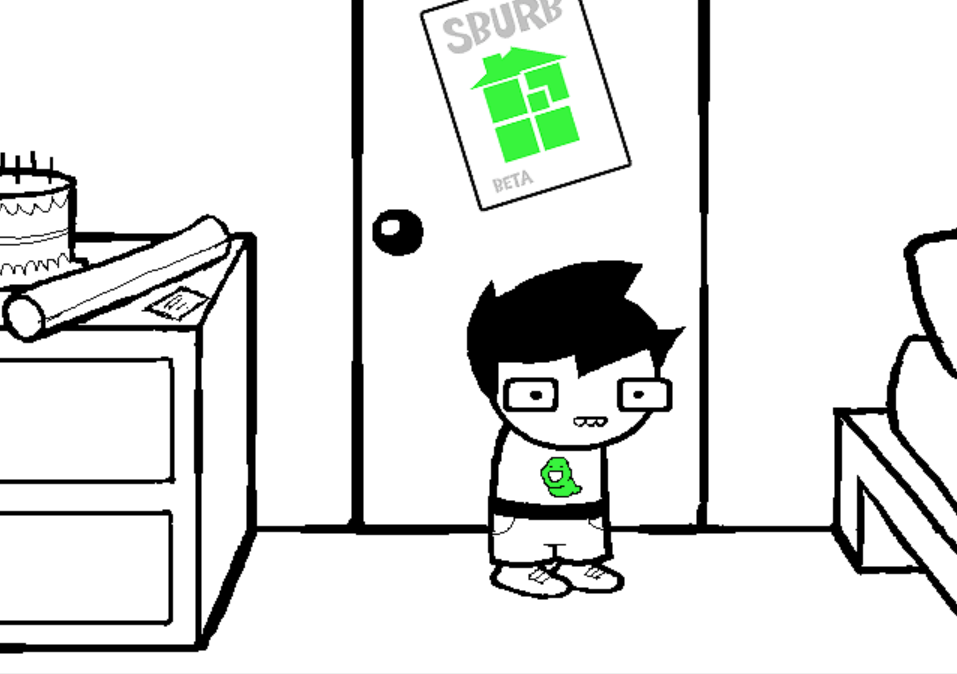Revisiting Homestuck in 2020: Introduction
A short bite of reflection before we get into the reread.
Hey. As my predecessors have tried time and time again, it seems as good of a moment as any to tell, or re-tell, you about Homestuck. Yeah, I know.
Andrew Hussie’s mixed media, genre-aware, and era-defining webcomic made up of approximately 8,000 pages—held by those who experienced it in a tight container of contempt, embarrassment, and/or high regard—began on April 13, 2009 with the humble request to give a name to a young man who stands in his bedroom. It then went on to have a 7-year run. And some game spin-offs and some other shit that are still putting food on the table of l’auteur I guess, but we’re going to stay focused on the original comic where the nostalgia lies.
“A tale about a boy and his friends and a game they play together,” remains the polysyndetic description on the story’s site page, and it is a purposefully reductive one.

John Egbert in all his glory. It’s his 13th birthday.
But maybe you’re not familiar with the comic, which is extremely plausible. After all, the only reason my friends and I, as well as many other teenagers at the time, stumbled upon it was through the entropy of nascent Tumblr, lighter blue and writhing with fandom larvae.
History
In 2007, the site MS Paint Adventures was created by an American artist and writer named Andrew Hussie to host his webcomics. Using the eponymous bare-bones software combined with jerky Flash animation, he would hone his distinct art style of bold pixel line art, monochrome color palettes, and cute, simple expressions for the characters.
The gimmick for these comics was that they were written in a reader-driven fashion. Users of the site would submit potential commands through forum posts or blog comments that were then selected by Hussie, where he would apply the commands to the characters and write the story in that direction for a number of pages, continuing this cycle until Hussie decided the comic was complete. It was a sort of cooperative choose-your-own adventure with a competent improviser at the helm.

Homestuck was the fourth MSPA comic to forge its existence this way. However, roughly one year into the story (Act IV), Hussie informed readers that he would no longer be taking command suggestions, at least not directly. Any further progression of this already-dense mishmash of characters and tedious lore (we will get into this, don’t fret) was now under his full control. As Homestuck expanded, so too did its reader base, and Hussie was able to hire additional artists, animators, and musicians to assist in its execution. [Toby Fox, the creator of Undertale, worked on several albums for the comic, and many may recognize Sans’s theme “Megalovania” from its origins in a Homestuck flash animation.]
While keeping the text-based adventure style of second-person storytelling (e.g. “You do this, and this happens as a result”), the actual bulk of Homestuck’s story is communicated through conversations between characters over a chat client. So, a single “page” may consist of one comic panel, but these chat logs can extend the scrollbar by a mile. It’s a risky creative decision to include so much reading. Hussie’s clever characterizations and sharp humor make up for this the majority of the time.

An early pesterlog between two main characters, exemplifying how the author creates unique voices within text
Rereading in The Year 2020
Now that the medium has been plucked and laid bare, it will be easier to approach this reread with the context of early 2010s internet culture in mind. Warnings for casual ableism and poorly aged jokes apply for the entirety of the webcomic, including Act I. More specific content warnings will be included at the beginning of each subsequent recap as the Acts grow longer and potentially disturbing events become more frequent.
My intentions with this reread are to spark lighthearted critical analyses and discussions of a piece of writing that shaped my youth. I also aim to track and explain the plot elements as they grow more and more convoluted, because this is something I never did when I followed the webcomic as a teen. It was easy to ignore the ridiculous meta game mechanics and meta story callbacks because we all accepted that it was meant to be ridiculous, and the most fun part was always reading/watching the character interactions (read: shipping). But at the ripe old age of our mid-twenties, we are a bit more familiar with how to mentally organize an overload of information, and it seems pertinent to any decent analysis of Homestuck given Hussie’s true dedication to making things difficult.
With that said, the bunny’s in the box. I’m allocating my strife specibus to “cringekind.” Let’s Read Homestuck.


